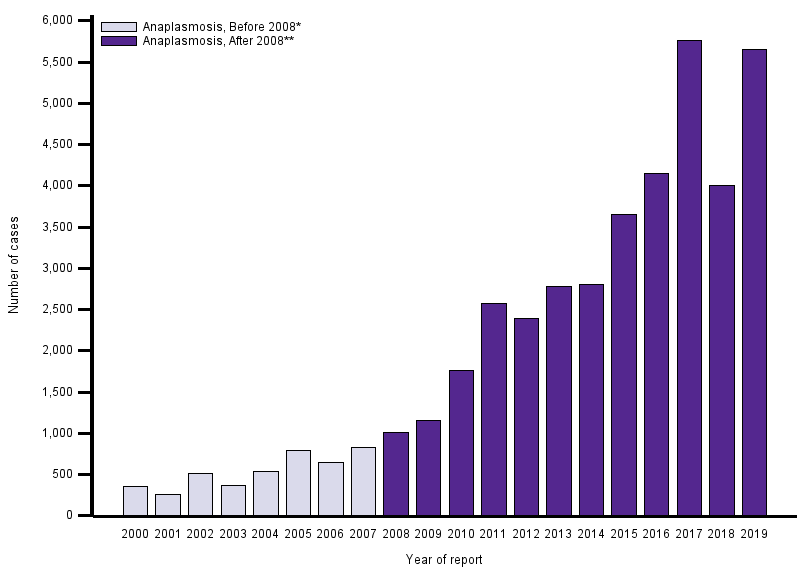Beware Blacklegged Ticks ... Transmitting Lyme Disease and Anaplasmosis
"There has been a rise in cases. Anecdotally, my colleagues and I are seeing a larger number than in past years.""This is the first year I can remember that we have seen multiple cases in a relatively short period of time.""They both [Lyme disease and Anaplasmosis] make people feel pretty dreadful."Dr.Gerald Evans, infectious disease specialist, Kingston Health Sciences Centre, Queen's University
 |
- Although cases of anaplasmosis can occur during any month of the year, the majority of cases reported to the CDC have an illness onset during the summer months and a peak in cases typically occurs in June and July.
- This period is the season for nymphal blacklegged ticks. Nymphal blacklegged ticks bite people and can spread the pathogen.
- A second, smaller peak occurs in October and November when adult blacklegged ticks are most active.
Health officials in upper New York State are seeing a spike in cases of anaplasmosis; from early July cases had quadrupled from a year earlier in Warren County, New York, not far from the Canadian border. Authorities caution this to be yet another reason for precautions to avoid tick bites. For Lyme disease transmission ticks generally must be attached to human skin for over 24 hours to transmit the pathogen, but evidence exists that faster transmission of anaplasmosis takes place, with no telltale rash left, as occurs with Lyme disease.
 |
| Facty Health |
The poppy-seed-size and slightly larger ticks are difficult to notice, making it imperative that when people are in wooded areas where wildlife abound, particularly mice and deer, that they carefully scrutinize themselves and their pets after exposure, to detect the presence of these tiny creatures and to take careful steps to extract them, particularly the head, from adhesion to the skin.
Lyme disease has a more gradual, subtle presence, generally starting with a rash in a bullseye shape. Following symptoms are inclusive of joint and muscle aches, fatigue, headache and low fever. Later stages of Lyme can lead to cardiac and neurological problems. Anaplasmosis, on the other hand, usually causes fever, chills, severe headache, nausea, vomiting and muscle aches. An enlarged liver and spleen as well as low white-blood-cell and platelet counts can also result.
 |
| Facty Health |
Anaplasmosis is rarer than Lyme disease, and can be treated with doxycycline, the antibiotic prescribed for treatment of Lyme. Warmer winter seasons have encouraged a rise in the presence of bacterium Borrelia burgdorferi in ticks carrying Lyme disease but those same ticks are also vectors of the bacterium carrying anaplasmosis. The result is increased numbers of anaplasmosis are being seen among the public.
The bactrerium Anaplasma phagocytophilum is transferred by tick bite to cause anaplasmosis in people and livestock. And now it is arriving in Ontario with researchers reporting the first known human case in 2018, acquired from a blacklegged tick, whereas the first cases reported in the United States go back to 1994, in Minnesota and Wisconsin. Doctors had seen the disease in people who had travelled to the U.S. where cases were fairly common, but never before acquired in Ontario.
Now, despite the fact that borders between the two countries have been closed to travel during the global pandemic, and few Canadians are travelling to the United States, cases among Ontarians have arisen indicating that they were acquired through tick bites near home. Recent research from the University of Ottawa found one in three blacklegged ticks tested positive for Lyme disease.
 |
| Facty Health |
In roughly one percent of cases of this tick-borne illness, it can be fatal, according to the U.S. Centres for Disease Control. Those over age 60 and people who fail to get treatment quickly are most at risk for severe outcomes. The best possible course of ideal action is, of course, avoidance. Wearing clothing that covers the skin, and vigilance to the presence of ticks on return from an outdoor hike in a forested area.

Labels: Anaplasmosis, Lyme Disease, Tick Infections

0 Comments:
Post a Comment
<< Home